The Subcool Metering Device Market is estimated to be valued at USD 371.0 million in 2025 and is projected to reach USD 664.4 million by 2035, registering a compound annual growth rate (CAGR) of 6.0% over the forecast period.
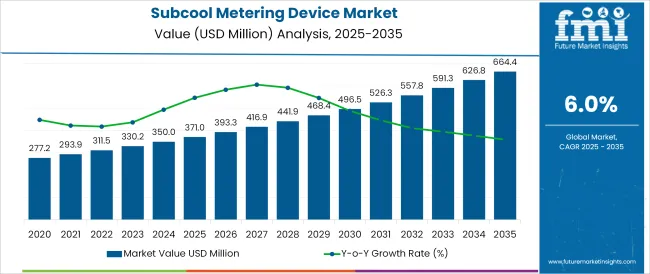
The subcool metering device market is experiencing significant growth as demand intensifies for accurate superheat and subcool measurements in HVAC and refrigeration systems. Global pressure to reduce carbon footprints, coupled with stricter energy-efficiency regulations, is compelling the adoption of precise diagnostic and monitoring tools across industrial, commercial, and residential HVAC applications.
Manufacturers are innovating with IoT enabled digital meters and sensor-integrated platforms that enable real-time temperature and pressure data logging. These devices help optimize refrigerant charge levels, reduce energy consumption, and extend the lifecycle of HVAC assets.
Growing usage of low-GWP refrigerants and variable-speed compressors further necessitates accurate system tuning driving the need for high-performance metering tools. Industry investments in predictive maintenance, smart building automation, and sustainable cooling technologies are opening long-term growth avenues.
The convergence of smart diagnostics, automation systems, and mobile connectivity is expected to enhance product versatility and position subcool metering devices as essential tools for HVAC optimization across industries.
The market is segmented by Temperature, Type, and End Use Industry and region. By Temperature, the market is divided into 50°F to 150°F, 150°F to 250°F, 250°F to 400°F, and -40 to 50 °F. In terms of Type, the market is classified into Digital and Gauge Meter.
Based on End Use Industry, the market is segmented into Industrial HVAC, Data Centers, Automotive, Residential HVAC, and Commercial HVAC. Regionally, the market is classified into North America, Latin America, Western Europe, Eastern Europe, Balkan & Baltic Countries, Russia & Belarus, Central Asia, East Asia, South Asia & Pacific, and the Middle East & Africa.
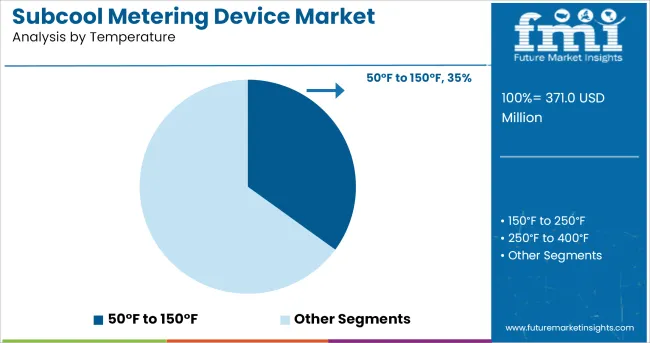
The 50°F to 150°F range is projected to account for 35.0% of the market revenue in 2025 under the temperature category, making it the leading segment. This dominance has been supported by its broad applicability across most HVAC and refrigeration systems where subcooling typically occurs within this temperature range.
Devices calibrated for this window provide optimal accuracy for diagnosing system efficiency and refrigerant charge levels. Technicians and facility managers favor this range due to its compatibility with commonly used refrigerants and its effectiveness in identifying energy losses or system malfunctions. Additionally, increased demand for energy audits and compliance reporting in climate-sensitive applications has necessitated reliable readings within this range
As environmental regulations push for fine-tuned performance in cooling systems, devices designed for 50°F to 150°F measurement are being adopted as the industry standard for reliable thermal diagnostics.
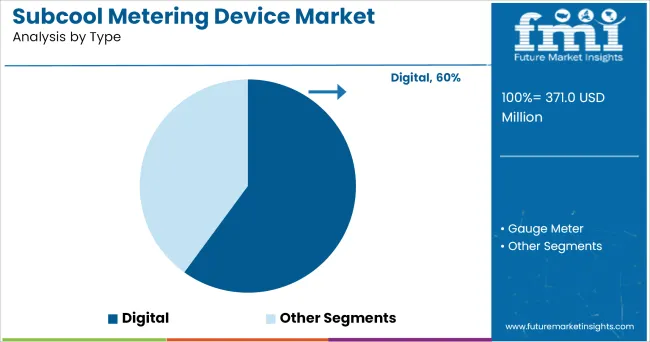
Digital subcool metering devices are expected to command 60.0% of the market revenue share in 2025 under the type category, positioning them as the dominant product type. This leadership is attributed to their high accuracy, user-friendly interfaces, and real-time data capabilities, which allow technicians to obtain subcool readings with minimal error and high repeatability.
The integration of wireless connectivity, mobile app compatibility, and cloud-based data storage has expanded the use cases of digital meters in predictive maintenance and remote diagnostics. Moreover, digital meters support multi-refrigerant calibration and automated calculations, eliminating the need for manual charts and increasing workflow efficiency.
Their growing adoption is being driven by the need for standardized, scalable solutions across complex HVAC installations in commercial and industrial environments. The rising trend of smart HVAC systems has further reinforced digital meter adoption, making them essential in modern system design and maintenance.
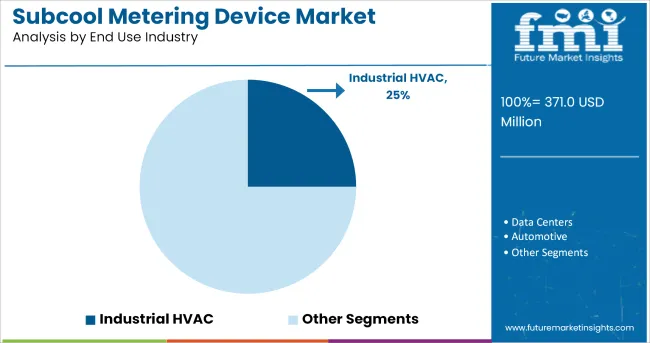
The industrial HVAC sector is projected to hold 25.0% of the total market share in 2025, establishing it as a key end-use segment. This is being driven by the complexity and scale of HVAC systems in manufacturing plants, refineries, data centers, and cleanroom environments where accurate thermal control is mission-critical.
Subcool metering devices have become indispensable for managing energy consumption, improving system reliability and ensuring regulatory compliance in industrial settings. The rising cost of energy and the push toward zero-waste operations have elevated the need for performance diagnostics tools capable of supporting preventative and condition-based maintenance regimes.
Industrial operators are integrating metering devices into building management systems to enable real-time monitoring and automated alerts, reducing downtime and increasing operational efficiency. As industrial facilities modernize and retrofit their HVAC infrastructure to meet green building codes and ISO standards, the demand for robust, high-accuracy metering tools is expected to grow steadily within this sector.
With rapid urbanization across countries there has been an increase in demand for HVAC systems from automotive, commercial as well as in industrial and residential sectors. The demand for district heating systems in colder regions has also been increasing.
These systems provide comfort to people in colder regions as well as maintain the economy of scale utilizing limited energy. Demand for such HVAC systems is anticipated to create significant opportunities in the subcool metering device market over the forecast period.
Regular monitoring of HVAC system is essential in the commercial sector henceforth subcool metering devices are used obligatory. Also, in recent years we have seen rapid growth in commercial buildings, malls, hospitals and data centres.
As more and more companies are set up, owing to the growing demand for new technologies, products, services, and the insatiable need for 24/7 connectivity, the energy expended in data centres would also increase, and so will the level of pollution. Thus it is anticipated to see an upsurge in the subcool metering device consumption to maintain constant sub cooling in the industrial or commercial coolers.
Due to the need for mass cooling of heat, automation has become a strong trend in the subcool metering device market of late. The market is shifting towards Industry 4.0 norms, leading to the promotion and almost universal adoption of new technologies.
Recent developments to digital subcool metering device have given a boost to the market. The automation of processes necessitates the use of precise metering in order to carry out effective cooling, so that the process is efficient and effective, which makes digital subcool metering device an ideal tool.
Consumption from East Asia is expected to rise exponentially in the forecast period. Owing to the Increasing population, growth in consumer spending, middle class growth and the movement of peoples occurs towards sophisticated and rich areas. This region expected to grow at a substantial growth rate in the forecast period owing to the rise in HVAC system market in this region.
Refrigeration problems due to subcooling has increased drastically in automobiles forced to use this metering device for monitoring. Manufacturing companies in East Asia trying to target North America region to capture the market of subcool metering device in near future to increase their market presence.
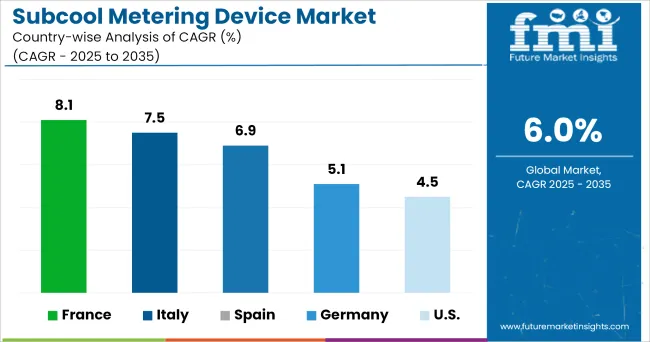
Demand in Europe grown has been growing considerably over the recent years and this trend is projected to persist over the coming years. This is attributed to strategic development by market player for improving market presence in the region. Environmental norms on use of particular refrigerant for A/C expected to see upsurge in sales.
Besides, countries such as UK, Germany, and France have been healthy markets because of the prominent sale of automobiles and HVAC systems. These factors are expected to create positive prospects for the market growth in the region.
High intensity of intra European trade and robust process of integration within this area is pushing the European Subcool Metering Device market. There are many opportunities for new entrant from this region to get into global Subcool Metering Device market as there is less intensity of manufacturers in this region.
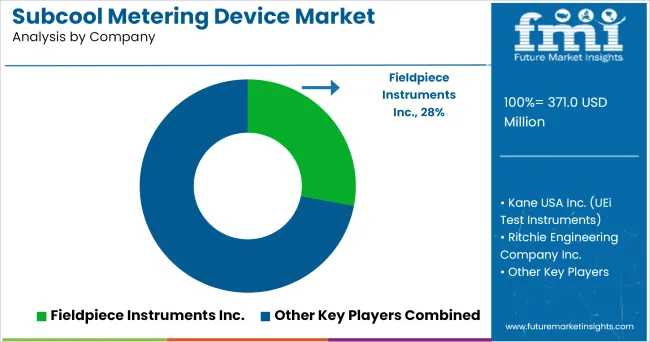
Some of the leading manufacturers and suppliers include
The leading manufacturers and supplier have established longstanding contracts with end-users i.e. service providers to supply Subcool Metering Device. Furthermore, manufacturers are focused on establishing their manufacturing facilities in the countries such as UK, USA, and China to cater increasing demand in the region.
The report is a compilation of first-hand information, qualitative and quantitative assessment by industry analysts, inputs from industry experts and industry participants across the value chain.
The report provides in-depth analysis of parent market trends, macro-economic indicators and governing factors along with market attractiveness as per segments. The report also maps the qualitative impact of various market factors on market segments and geographies.
The global subcool metering device market is estimated to be valued at USD 371.0 million in 2025.
The market size for the subcool metering device market is projected to reach USD 664.4 million by 2035.
The subcool metering device market is expected to grow at a 6.0% CAGR between 2025 and 2035.
The key product types in subcool metering device market are 50°f to 150°f, 150°f to 250°f, 250°f to 400°f and -40 to 50 °f.
In terms of type, digital segment to command 60.0% share in the subcool metering device market in 2025.






Full Research Suite comprises of:
Market outlook & trends analysis
Interviews & case studies
Strategic recommendations
Vendor profiles & capabilities analysis
5-year forecasts
8 regions and 60+ country-level data splits
Market segment data splits
12 months of continuous data updates
DELIVERED AS:
PDF EXCEL ONLINE
Metering Pump Market Size and Share Forecast Outlook 2025 to 2035
Power Metering Market
Smart Water Metering Market Size and Share Forecast Outlook 2025 to 2035
India Power Metering Market Insights – Trends & Forecast 2025 to 2035
Residential Smart Water Metering Market Size and Share Forecast Outlook 2025 to 2035
Device-Embedded Biometric Authentication Market Size and Share Forecast Outlook 2025 to 2035
IoT Device Management Market Size and Share Forecast Outlook 2025 to 2035
IoT Device Management Platform Market Size and Share Forecast Outlook 2025 to 2035
Drug Device Combination Products Market Size and Share Forecast Outlook 2025 to 2035
FBAR Devices Market
X-Ray Device Market Size and Share Forecast Outlook 2025 to 2035
Power Device Analyzer Market Growth – Trends & Forecast 2025 to 2035
Snare devices Market
Biopsy Device Market Forecast and Outlook 2025 to 2035
Timing Devices Market Analysis - Size, Growth, & Forecast Outlook 2025 to 2035
Spinal Devices Market Size and Share Forecast Outlook 2025 to 2035
Mobile Device Management Market Analysis by Deployment Type, Solution, Business Size, Vertical, and Region Through 2035
C-Arms Devices Market Analysis – Trends & Forecast 2024-2034
Venous Device Market
Serial Device Servers Market

Thank you!
You will receive an email from our Business Development Manager. Please be sure to check your SPAM/JUNK folder too.
Chat With
MaRIA